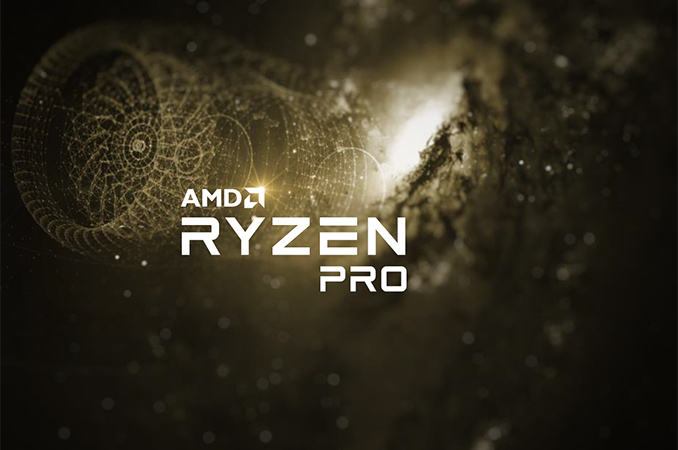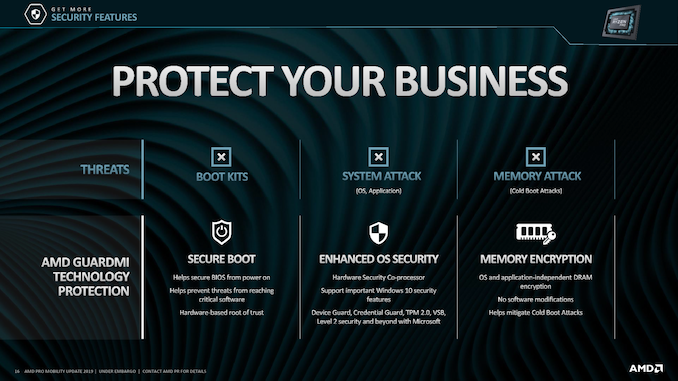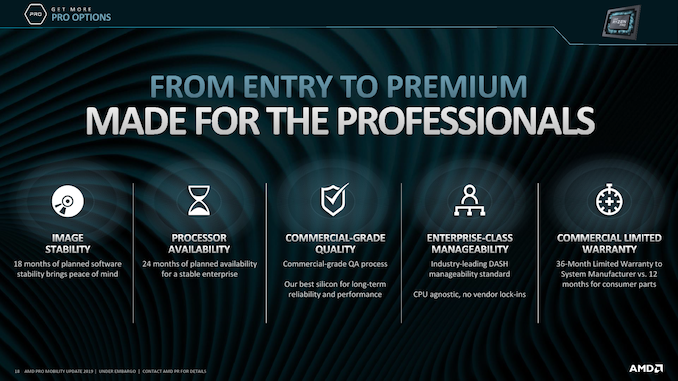AMD Announces Ryzen Pro 3000 Series CPUs For Q4
by Anton Shilov on September 30, 2019 3:30 PM EST
AMD on Monday announced the availability of its 3rd generation Ryzen Pro processors for commercial and small business desktop computers. As with their consumer counterparts, the new Pro CPUs will pack up to 12 cores, and they will be available inside of desktops by HP and Lenovo in the fourth quarter. In addition, AMD also announced new Ryzen Pro and Athlon Pro 3000-series APUs with integrated graphics.
Small Desktops Get 12-Core CPUs
AMD’s latest generation of Ryzen Pro CPUs are based on the same Zen 2 "Matisse" microarchitecture as the consumer chips introduced earlier this summer. The initial Ryzen Pro 3000-series family will include three models in the AM4 form-factor, with all of them set for a 65 W TDP. These include the the 12-core Ryzen 9 Pro 3900, the eight-core Ryzen 7 Pro 3700, and the six-core Ryzen 5 Pro 3600.
The processors will feature support for all of AMD’s Pro-series features, including a built-in TrustZone security processor, DASH manageability, Secure Boot, Content Protection, per-Application security, fTPM 2.0, Transparent Secure Memory Encryption (TSME), and some other technologies that differentiate AMD’s Pro from the firm’s regular CPUs for client PCs. Once thing to keep in mind is that these products are truly CPU, and as such do not have integrated graphics.
| AMD's 3nd Gen Ryzen Pro Specifications | |||||||
| Cores Threads |
Frequency | Cache L2 + L3 |
GPU | TDP | |||
| Base | Boost | ||||||
| Ryzen 9 Pro 3900 | 12/24 | 3.1 GHz | 4.3 GHz | 70 MB | - | 65 W | |
| Ryzen 7 Pro 3700 | 8/16 | 3.6 GHz | 4.4 GHz | 36 MB | - | 65 W | |
| Ryzen 5 Pro 3600 | 6/12 | 3.6 GHz | 4.2 GHz | 35 MB | - | 65 W | |
Initial customers for the Ryzen Pro 3000-series processors will be HP and Lenovo, with the former using them inside its EliteDesk 705 G5 SFF and Mini desktops, while Lenovo will use the chips for their upcoming ThinkCentre M75s-1 SFF and M75q-1 Tiny desktops.
Commercial PCs Get Radeon Vega Graphics
Meanwhile, for more streamlined PCs that need integrated graphics and fewer CPU cores, AMD has also introduced new APUs based on their 12nm Zen+ "Picasso" design, analogous to mainstream their Ryzen 3000 APUs. The new Ryzen 3000 Pro APUs will include the quad-core Ryzen 5 Pro and Ryzen 3 Pro, and the dual-core Athlon Pro 3000-series CPUs, all of which include integrated Radeon Vega graphics. The chips featuring TDPs of 65 W and 35 W depending on the SKU, with the processors slated to be used for select machines from HP and Lenovo, according to AMD.
| AMD's 3nd Gen Ryzen Pro & Athlon Pro Specifications | |||||||
| Cores Threads |
Frequency | Cache L2 + L3 |
GPU | TDP | |||
| Base | Boost | ||||||
| Ryzen 5 Pro 3400G | 4/8 | 3.7 GHz | 4.2 GHz | 6 MB | 11 CUs | 65 W | |
| Ryzen 5 Pro 3400GE | 3.3 GHz | 4.0 GHz | 35 W | ||||
| Ryzen 3 Pro 3200G | 4/4 | 3.6 GHz | 4.0 GHz | 8 CUs | 65 W | ||
| Ryzen 3 Pro 3200GE | 3.3 GHz | 3.8 GHz | 35 W | ||||
| Athlon Pro 300GE | 2/4 | 2.4 GHz | 3.3 GHz | 5 MB | 3 CUs | 35 W | |
Related Reading:
- AMD Launches 2nd Gen Ryzen Pro & Athlon Pro APUs
- AMD Launches Ryzen Pro with Vega: Mobile APUs and Desktop APUs
- AMD Launches Ryzen PRO CPUs: Enhanced Security, Longer Warranty, Better Quality
Source: AMD












22 Comments
View All Comments
oRAirwolf - Monday, September 30, 2019 - link
It is disappointing that their APU's are a generation behind. That makes it a tough sell. It's easy to recommend a 9th gen Intel CPU with integrated graphics over a 10th gen because there is basically no noticeable difference. There is, however, a significant difference in performance going from a Zen+ to a Zen2 arch processor.rahvin - Monday, September 30, 2019 - link
If AMD wanted to strip their integrated GPU's down to the same power budget and capability as Intel they could offer the same.My bet is they are going slow while trying to develop a GPU chiplet that would slot into the same die they've already got. The laptop chips with integrated graphics are always behind in performance.
Though intel uses laptop chips as a test bed for the next process I think AMD's method has promise because they are likely trying to figure out how to chiplet the GPU side and slot it into the existing design. One of the advantages of AMD's chiplet design is the ability to slot it into a chip with a chiplet just like more CPU cores. In an ideal world you'd have 1 cpu chiplet, 1 gpu chiplet and a handful of IO chiplets that allow you assemble a broad product line from independent GPU, to combined CPU-GPU products. Such a product line would allow you to maximize the chiplets performance and yields while maintaining a broad segment. This was always the most interesting possibility with the chiplets to me.
deil - Tuesday, October 1, 2019 - link
in ideal world you have 6 slots you can fill with gpu chiplets/cpu chiplets, so they could make abatch of configurations
all from 4/8 with 8 CU (1/1) up to 20/40 cpu with 8 CU (5/1) and 12/24 one with 24 CU (3/3) and 8/16 with 32 CU (2/4)
and then pick first one as entry, second for work, third one as mix of performance, last one as gaming....
damianrobertjones - Tuesday, October 1, 2019 - link
Mmmm... Capitals!wilsonkf - Tuesday, October 1, 2019 - link
Isn't the next gen APU still an integrated design?damianrobertjones - Tuesday, October 1, 2019 - link
Mmmm... chiplet.eek2121 - Tuesday, October 1, 2019 - link
AMD is trailing on mobile parts because desktop and server parts are high volume, high margin products. Mobile parts are high volume, but low margin because you almost exclusively deal with an OEM that buys in volume. With desktop parts, you have much smaller OEMs as well as consumer DIYers buying from stores like newegg and Amazon.The True Morbus - Monday, September 30, 2019 - link
Not in gaming though, so it's not that big of a deal, to be honest.Pyrostemplar - Tuesday, October 1, 2019 - link
While that is a compliment to the Zen 2 improvements, it is quite understandable that it is on a prior arch due to the manufacturing node - 7nm demand outstrips capacity causing supply issues and it is expensive. APUs are the lower margin per area so they get the previous, less expensive stuff, while high margin CPUs (Epyc) gets the high performance leading edge.And for customers whats on the table is not so much that the Zen 2 is better, but how good is the Ryzen 3000 APUs compared to competition (from Intel).
Adi_Nemesis - Monday, September 30, 2019 - link
The only thing of note is the 65W 12-Core. Everything else is product segmentation via feature differentiation of existing SKUs.